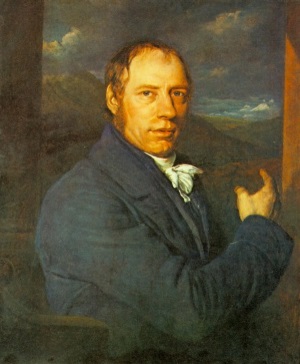Richard Trevithick - inventor and father of industrial revoluation

Richard Trevithick - an inventor, mining engineer, builder of wheeled steam engines years before Stephenson, one of the Fathers of the industrial revolution, overseas engineer, refused support or a pension from the British Government, died in poverty.
Richard Trevithick was born on 13th April 1771 in Tregajorran Cornwall, the son of the manager of Dolcoath Mine.
By the 1780s, as a boy he did experiments to improve the efficiency of the beam engines.His aim was to make smaller and lighter steam engines with stronger boilers to generate higher steam pressures and thus more power.
Richard was educated at Camborne School.
Trevithick was tall and strong.
At six feet two inches high and was known as the Cornish giant.
At the age of eighteen he could throw sledge hammers over the tops of engine houses. Trevithick also had the reputation of being one of the best wrestlers in Cornwall.
Trevithick went to work with his father at Wheal Treasury mine.
After making improvements to the Bull Steam Engine, Trevithick was promoted to engineer of the Ding Dong mine at Penzance.
While at the Ding Dong mine he developed a successful high-pressure engine for raising the ore and waste from mines.
Trevithick ran a steam engine through the streets of Camborne on Christmas Eve 1801. Camborne Hill was the steepest hill in the district and horses had difficulty pulling loads up it, so the fact that the new steam engine could reach the top showed the potential of steam. His cousin Andrew Vivian was at the controls.
Stephenson's Rocket it should be remembered, did not run between Stockton & Darlington until 1821.
In 1803 a company called Vivian & West, agreed to finance Trevithick's experiments. Vivian & West were disappointed with Trevithick's lack of practical success and they withdrew from the project.
In 1803 he built another early self-propelled road vehicle, a stagecoach fitted with a steam engine called the London Steam Carriage, but that proved more expensive to run than a horse-drawn carriage and was abandoned.
On 21 February 1804 his Penydarren engine won a bet of 500 guineas by hauling a 10-ton load over a 91/2-mile tramway - the world's first freight train. The Merthyr Tramroad at the Pen-y-Darren ironworks near Merthyr Tydfil in Wales was his venue.
Successfully travelling the nine miles from Pen-y-Darren to Abercynon. However it was too heavy for the rails, which had been designed for horse drawn trams, and it kept breaking the rails. It only did three journeys. Samuel Homfray, the sponsor and owner of the ironworks, came to the conclusion that Trevithick's invention was unlikely to reduce his transport costs and so he decided to abandon the project.
Trevithick was next employed by Christopher Blackett, who owned the Wylam Colliery in Northumberland. A five-mile wooden wagonway had already been built in 1748 to take the coal from Wylam to the River Tyne. Blackett wanted a locomotive that would replace the use of horse-drawn coal wagons. The Wylam locomotive was built but weighing five tons, it was too heavy for Blackett's wooden wagonway. It was abandoned
By 1810 he was bankrupt and his family near-destitute. Trevithick found it difficult to persuade investors to fund his projects.
Without financial backing, Richard Trevithick had to abandon his plans to develop a steam locomotive. He then found work with a company who paid him to develop a steam dredger to dredge the Thames. He was paid sixpence for every ton lifted from the river.
Trevithick found it difficult to make money from his steam dredger and in 1816 he accepted an offer to work as an engineer in a silver mine in Peru. After some early difficulties, Trevithick's steam-engines were very successful and he was able to use his profits to buy his own silver mines. In 1826 war broke out in Peru and Trevithick had to get out quickly, leaving behind his steam-engines and silver mines.
After a unsuccessful spell in Costa Rica, Trevithick moved to Columbia, where he met Robert Stephenson, who was building a railway there . Stephenson gave Trevithick the money to pay for his journey back to Britain.
George Stephenson and others argued that Trevithick's early experiments were vital to the development of locomotives, but in February 1828 the House of Commons rejected a petition that he should receive a government pension. Trevithick continued to experiment with new ideas for steam engines. This included the propulsion of steamboats by means of a spiral wheel at the stern, an improved marine boiler, a new recoil gun-carriage and apparatus for heating apartments. Another scheme was the building of a 1,000 feet cast-iron column to commemorate the 1832 Reform Act.
All these schemes failed and Richard Trevithick died in extreme poverty at the Bull Inn, Dartford, on 22nd April, 1833. He left no money for his burial, so he faced the prospect of a pauper's funeral. However, when a group of local factory workers heard the news, they raised enough money to provide a decent funeral and he was buried in Dartford churchyard.
There is a statue to him in Camborne, outside the public library, holding a model of his locomotive. There is also a memorial window to him in Westminster Abbey.
This article has been kindly provided by Kernow Matters to Us and is part of the series on Famous Folk of Kernow (Cornwall).
- Cornish
- English
- Log in to post comments





